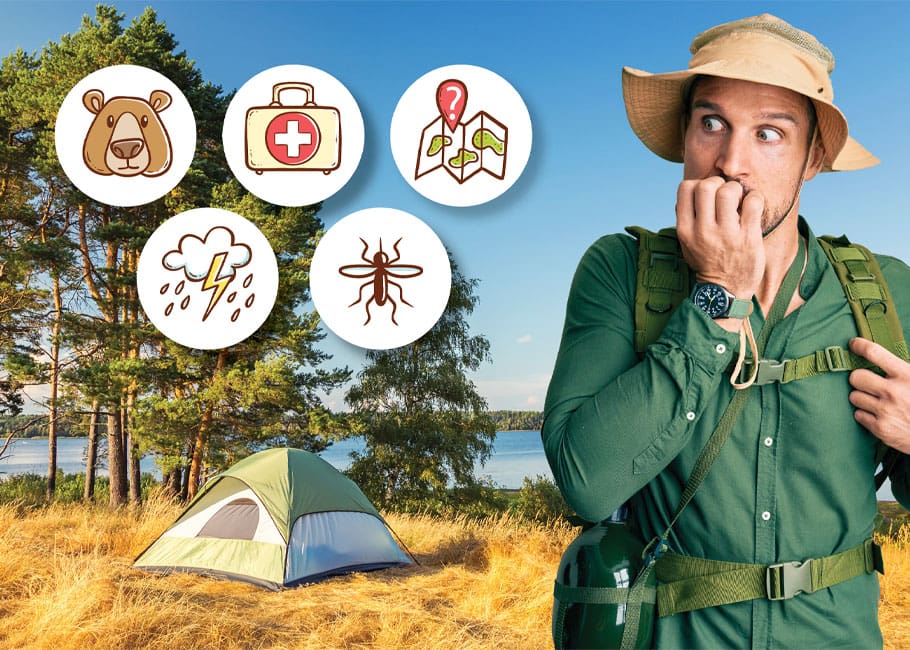
© KRAKENIMAGES.COM; SBORISOV; INSEMAR / STOCK.ABOBE.COM
Outdoors averse?
Tips for breaking into adventures as a nature newbie
While outdoor recreation is more popular than ever, not everyone is a veteran camper or experienced adventurer. In fact, heading into the great outdoors intimidates some people. Their inexperience can lead to bad—and potentially harmful—decisions.
The Connection recently spoke to accredited wilderness guide Elizabeth Andre, a professor of nature and culture in the Outdoor Education Department at Northland College in Ashland, Wisconsin, for expert tips on how to safely and responsibly recreate in the great outdoors.
Start simple. “When you’re just starting out, if you’re doing something with an objective hazard—like quickly flowing or large bodies of water or steep, slippery terrain—take a lesson, hire a guide or join a club,” advises Andre. This is especially true for activities that require some degree of skill, training and/or specialized equipment, like navigating a boat, rappelling off a cliff or scuba diving.
Take baby steps. As you gain more confidence and increase your skills, slowly branch out. “Start small, like going for a short hike in a small, easy park,” suggests Andre, noting you need to respect the activity, the area and the skill level required to recreate safely. “Don’t jump in too quickly by going on a weekend backpacking trip in a massive park,” she says. “Start with a day hike in a well-contained, well-marked place so you’re within your skill level and it will be enjoyable.”
If you’re trying stand-up paddle-boarding for the first time, don’t head to the ocean by yourself. Take a skilled friend and practice in a small lake.
Practice commonsense safety. While solo adventures can be fun, it’s always safer to travel with a companion, whether you’re tubing down a river, exploring narrow paths in a cave or bird-watching in the forest. And share your itinerary, even if you’re traveling with others. Include your destination, as well as when you plan to leave and return. Also, check the weather forecast and dress appropriately.
Do your research. Before going anywhere, Andre advises checking the destination’s website for closures, weather alerts or dangerous conditions. In some areas of California, for example, outdoor enthusiasts might want to know what to do in case of stumbling upon a mama Roosevelt elk during calving season.
Also, read the FAQs or “Plan your visit” section of websites offering information about your destination to minimize any surprises. For instance, you might need to purchase a permit for fishing or backcountry hiking.
You typically need to make campsite reservations ahead of time. And expect to pay an admission or parking fee at many recreation areas. Know the policies before you go.
Navigate with ease. While it’s convenient to rely on your cellphone’s GPS, have a backup plan. “I’m a huge advocate of having a paper map with you—either a waterproof map or inside a waterproof case,” Andre says, pointing out that tech can break, batteries die and cell service can be spotty. “Don’t just start walking. Follow the map as you go, paying attention to what you passed and what you should be expecting to see up ahead, like a trail junction or lake.” This advice holds true whether you’re kayaking, biking or horseback riding.
Be an environmental steward. “Familiarize yourself with the Leave No Trace guidelines,” suggests Andre (see “Leaving no trace”), who notes the importance of protecting the environment and being considerate of others enjoying the space. These principles outline ways to minimize your impact on plants, animals, water and other people while engaged in outdoor recreation.
“The outdoors is really not that scary,” says Andre. “We can overinflate our fears. [And] when you look at the stats of where you’re most likely to get injured, it’s far more likely to happen around your house.”
Experienced outdoor educator Elizabeth Andre suggests the following must-have supplies, at a minimum, regardless of activity:
- Cellphone (and a charging device)
- Waterproof or protected paper map
- Lightweight layers of synthetic clothing
- Raincoat
- Sun protection (hat, sunglasses, sunscreen)
- Bug spray
- Adequate water and calories (and purification tablets to make fresh water safe to drink)
- Headlight
- Backpack
- Supplies to make a fire if needed (e.g., matches, lighter)
- Supplies to signal others (e.g., mirror)
- Mylar emergency blanket (for sun shelter, warmth, wind/rain protection)
- Knife—LAB
Minimize your impact on plants, animals and other people by following the seven principles of Leave No Trace (LNT.org), which features the following:
- Plan ahead and prepare.
- Travel and camp on durable surfaces.
- Leave what you find.
- Dispose of any and all waste properly.
- Minimize your campfire impacts.
- Respect wildlife.
- Be considerate of others.—LAB
Costco Connection: Supplies and equipment for many outdoor adventures are available in Costco warehouses and at Costco.com.



